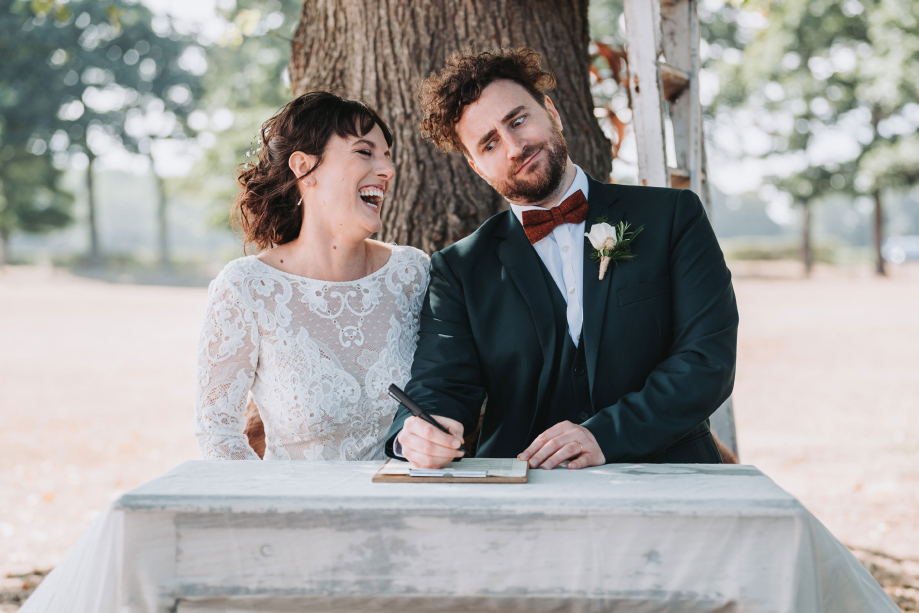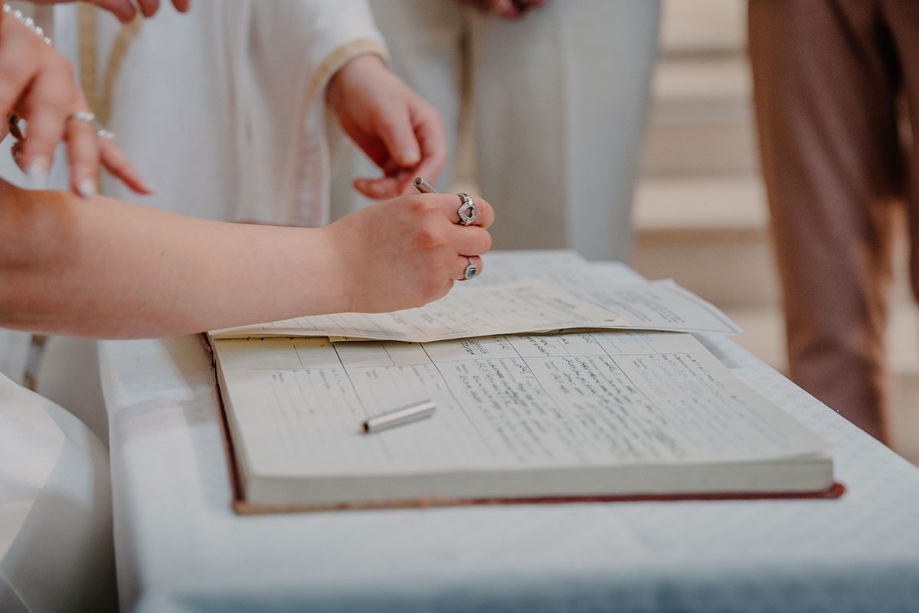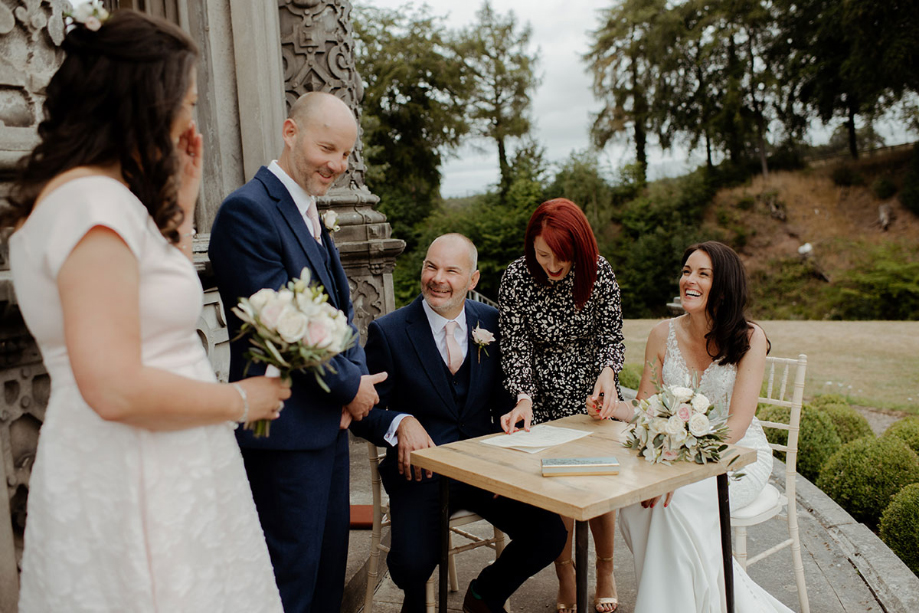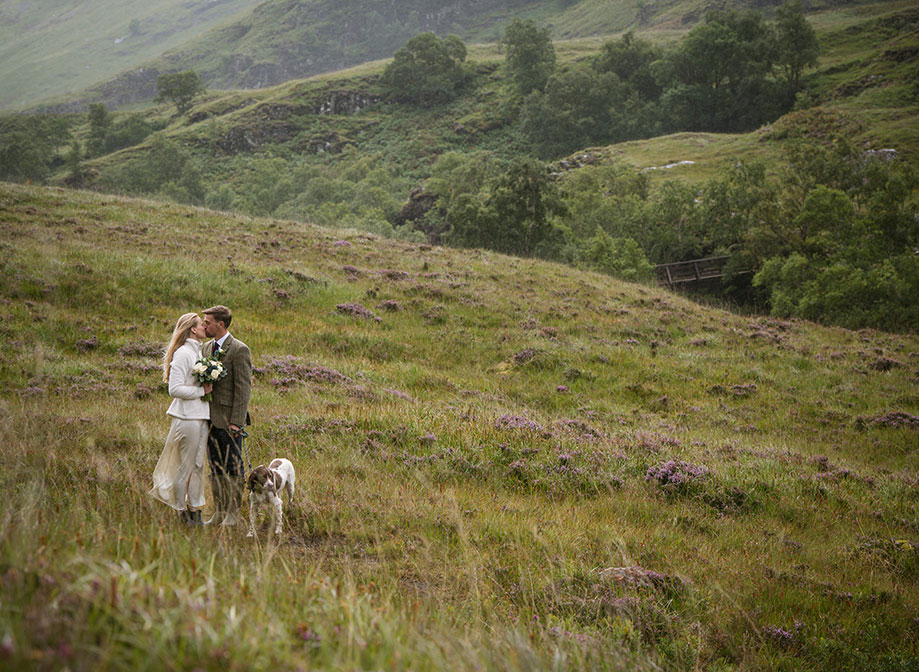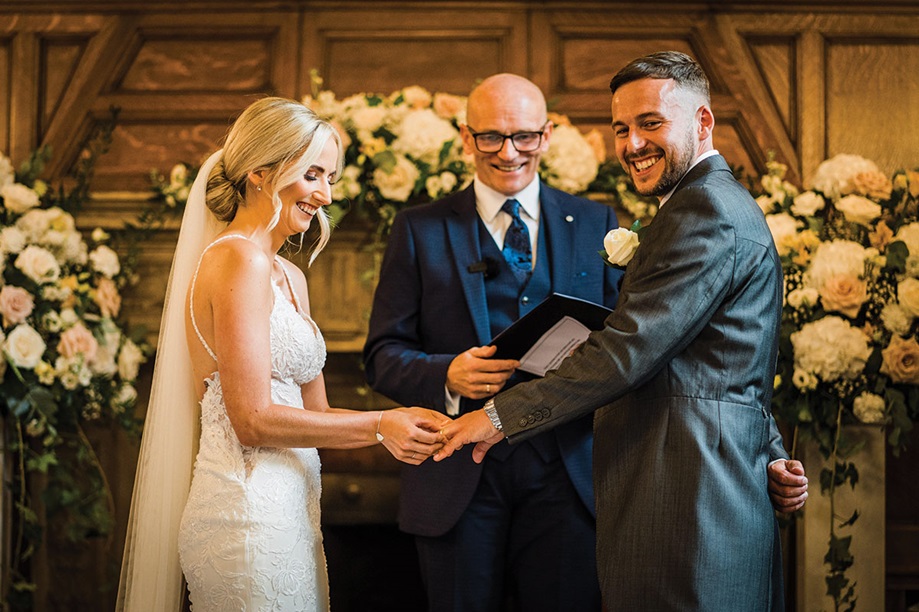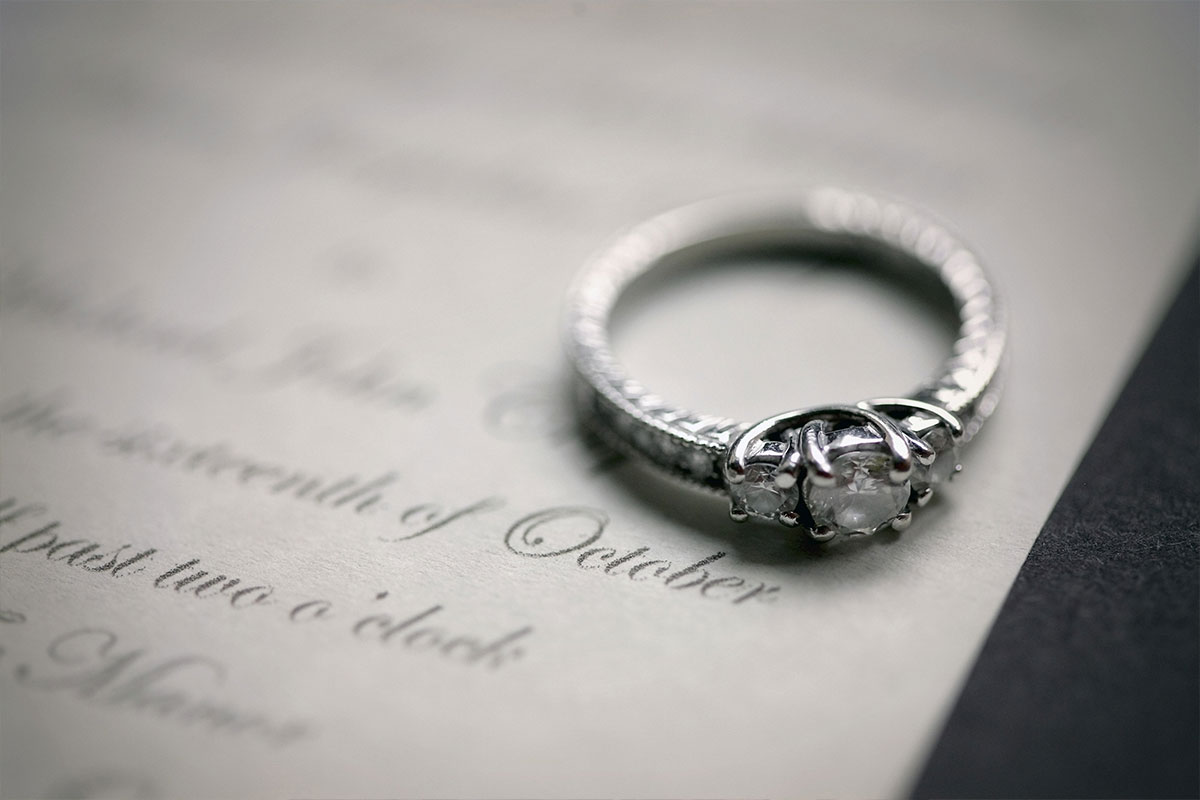We know paperwork’s not the most exciting bit of planning, but you won’t get very far down the aisle without it. We lay out what’s needed to get hitched in Scotland
People come from all over the world to get married in Scotland – and it’s not just because we have stunning scenery, enviable hospitality and warm and friendly folk. It’s also because the rules around where you can tie the knot are a lot more relaxed here than they are in many other countries.
That’s not to say anything goes: you still have to ensure everything is official and above board in order for the marriage to be legal. We chatted to industry insiders to find out how to make that happen.
Can you get married anywhere in Scotland?
“Before you do anything else, it is really important to work out exactly where you are going to have your ceremony,” says Craig Flowers of Independent Humanist Ceremonies. “That’s because, in Scotland, the licence to marry goes with the celebrant, so if you want to get married somewhere a bit different to the norm, you can make it happen – as long as you have the relevant permission.”
In other words, you can’t just decide you fancy a beach ceremony on the morning of your wedding because it’s a sunny day – the location has to be specified on the wedding schedule.
“You can marry up a mountain, in your garden, on a beach, at a special place to you, or at any venue in the country,” confirms celebrant Yvonne Hannah from Fuze Ceremonies.
“I have conducted large ceremonies in front of 140 guests in luxurious hotels and I have also married couples at the top of a mountain with only their parents present. I’ve got colleagues who have sat on a couch to deliver their couple’s ceremony in their living room. You don’t need to marry in your own council area – you have the freedom to do it absolutely anywhere in Scotland.”
What do we need to make our marriage legal?
You’re in love, you want to get married, and you’re ready to head down the aisle right now. We get it, but hold your horses for a moment: there are a few things you need to do before you can be lawfully wed.
“No matter where in Scotland you plan to tie the knot, and whether it’s a religious, civil, humanist or spiritual ceremony, you do require the same paperwork,” says Tania Walker of Edinburgh City Chambers. “Both halves of the couple are required to fill in an M10 form (C10 if it is a civil partnership) and provide the supporting paperwork that’ll have been outlined to you.
“In some instances you may be required to fill in additional paperwork too,” she continues. “If you’re not a British citizen, you have to complete the declaration of status by Non-UK Nationals form; if you were previously married, you must submit the divorce papers. And if a previous spouse has died, you are required to provide a death certificate.”
What are the marriage rules in Scotland?
“As long as we do three legal things, you can have what you want. It is your day, and as we say at Fuze, it really is your way,” continues Yvonne. “Some of our celebrants perform as many as three weddings a week, so they are definitely experts!”
“Ask questions if you’re unsure about anything,” advises Craig. “We’re always happy to help.”
What is an M10 form?
You’ll need two marriage notice application forms (known as M10 forms), as each party to the marriage must complete their own form, filling in their partner’s details in section G of the M10.
Read our guide for how to fill out the M10 form.
Where do I send my M10 form?
By law, you must submit the forms to the registry office closest to the venue or location where the ceremony will take place. “So if you live in Glasgow but are getting married on Luskentyre beach on the Isle of Harris, you would need to submit your M10 forms to the Harris registry office in West Tarbert,” explains Yvonne.
When to submit the paperwork
“Bear in mind that you cannot submit them any sooner than 12 weeks before the wedding or any later than 29 days before,” adds Craig.
Alan Edwards of Fuze Ceremonies adds: “But whatever you do, don’t leave it any later than 29 days before. You might have a wedding planned – but without the paperwork, absolutely nothing is legal!”
If you’re entering into a civil partnership, the information above is exactly the same, except the form is called a C10.
What documents do I need to get married?
“When returning these forms, you’ll need originals of your birth certificates, photographic ID such as a passport or driving licence and proof of address,” advises Yvonne. “And if you live overseas, you may need a visa.”
What if you’ve been married before? “You must be divorced at the time of your marriage and submit your Decree Absolute as part of your application to marry,” she tells us. “If you are a widow or widower, the registry office will want to see legal proof of this too.”
Can it just be the two of us at our ceremony?
You don’t need to have any guests but you can’t quite be on your own. “In order to be legally married, you must have two witnesses present who are adults over the age of 16,” explains Alan.
Who can be your wedding witness?
“This is usually where your chief bridesmaid and best man come in,” says Craig. “So long as they are over 16 years old and are of sound mind (AKA they haven’t had too many glasses of champagne!), they can witness the marriage. Everyone needs to understand what is happening, so if one of your witnesses is deaf, for example, you’ll need someone to interpret the ceremony for them.”
Submitting their details in advance helps the process run smoothly, advises Yvonne. “Detailing your two legal witnesses on a witness form supplied by the registry office is not an absolute must do, but it can help – it means your marriage schedule will have their details already on it when it’s time to sign,” she explains. “And if I know in advance who they are, I can ask them to come forward at the time of signing.”
What do I need to do before the wedding?
The registrar uses your M10/C10 form to create a legal document called a marriage schedule. “If you’re having a celebrant-led or religious ceremony, you must collect this document from the same registry office you submitted the M10/C10 forms to the week before your wedding,” stresses Yvonne. “Most registry offices will arrange a time for you to go and pick up this vital document. While it’s a lovely romantic thing to do together, you don’t both have to go. But at least one of you must go in person to sign for it and collect it.”
Craig emphasises that last point too: the marriage schedule will not be issued to anyone other than the individuals who’re getting married – so you can’t send a pal!
However, if you’re getting married in a registration office or having an authorised registrar lead the ceremony, the process is different: the registrar will bring the marriage schedule to your ceremony; you will not need to collect it. “Registrars are unique as we can attend to all the paperwork and tailor-make a ceremony,” notes Liz Ferguson, a district registrar in Stirling.
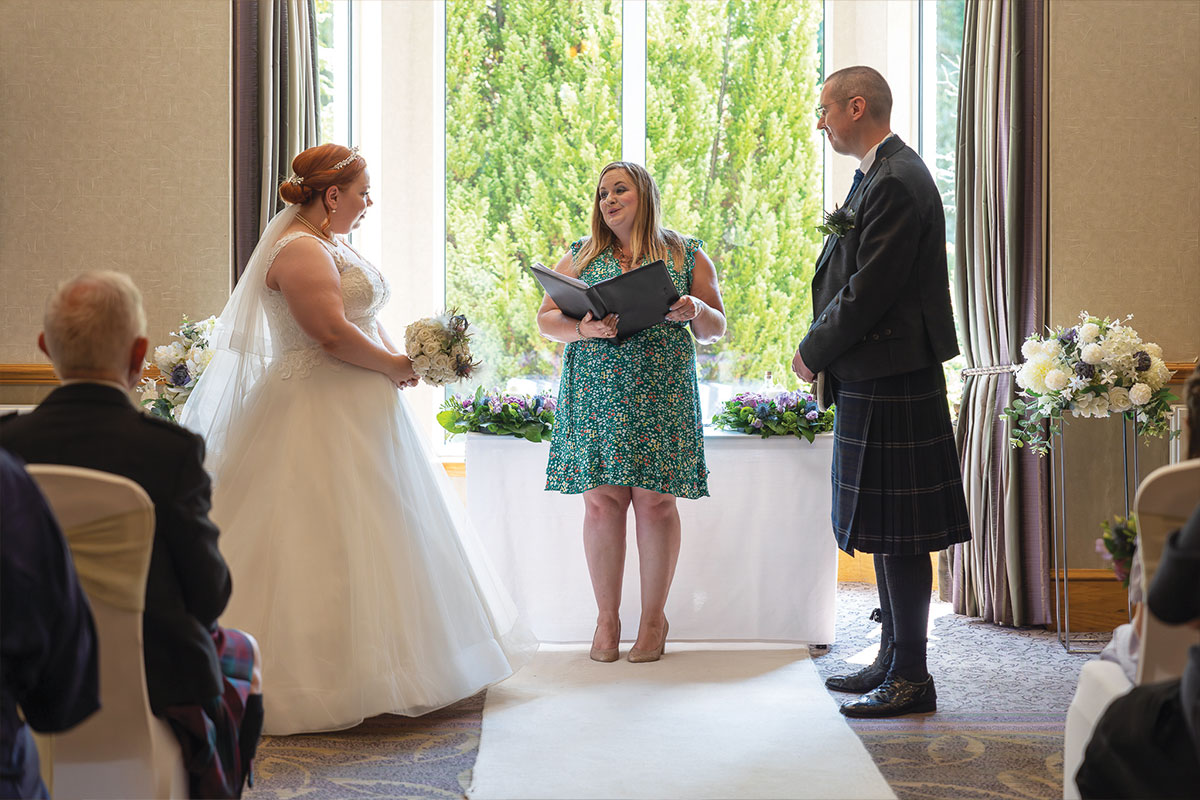
Celebrant Natalie Stevenson (pictured) loves to give her ceremonies a personal touch (Photo: Iain Spowart)
Who picks up the marriage schedule?
“If you are having a religious or belief ceremony (which includes humanist and interfaith ceremonies), you or your partner (or both of you) must collect this document no more than seven days prior to the ceremony,” Tania tells us. No one else can do this for you.
If your marriage is being conducted by a civil registrar, they will retain the schedule for completion on the day of the marriage (and return it thereafter).
What happens on the wedding day?
“The person conducting the wedding must be present in the room when you sign the marriage schedule,” says Craig. “You have to sign your name with a black fountain pen. The celebrant will normally have this with them.”
Alan advises: “Sign your maiden name even if you will be changing it to your new spouse’s surname. Your celebrant and witnesses are also required to sign this document.”
Without this document, the wedding cannot legally take place. “You must have your marriage schedule with you on the day of your wedding,” reiterates Yvonne. “It is the most important thing to pack. It must be in the room before I can start the ceremony, as without that piece of paper, I cannot legally marry you.”
What to do after getting married
If you’ve had an authorised registrar conduct the ceremony, they will be able to return the signed schedule to the office and register the marriage.
For celebrant or religious ceremonies, you must look after the document. “Don’t lose the signed marriage schedule!” says Yvonne. “Some venues will lock it away in a safe for you if you’re staying the night. Otherwise, put it somewhere safe in your room or the glove compartment of a locked vehicle, or give it to a trusted family member or friend to look after.”
There’s a tight turnaround for getting it back to the registry office. “You have three days from the wedding to return the marriage schedule to the same registry office where you submitted your M10 forms,” says Craig. “Thankfully, anyone trustworthy can do this for you – so don’t worry if you’re jetting off on honeymoon!”
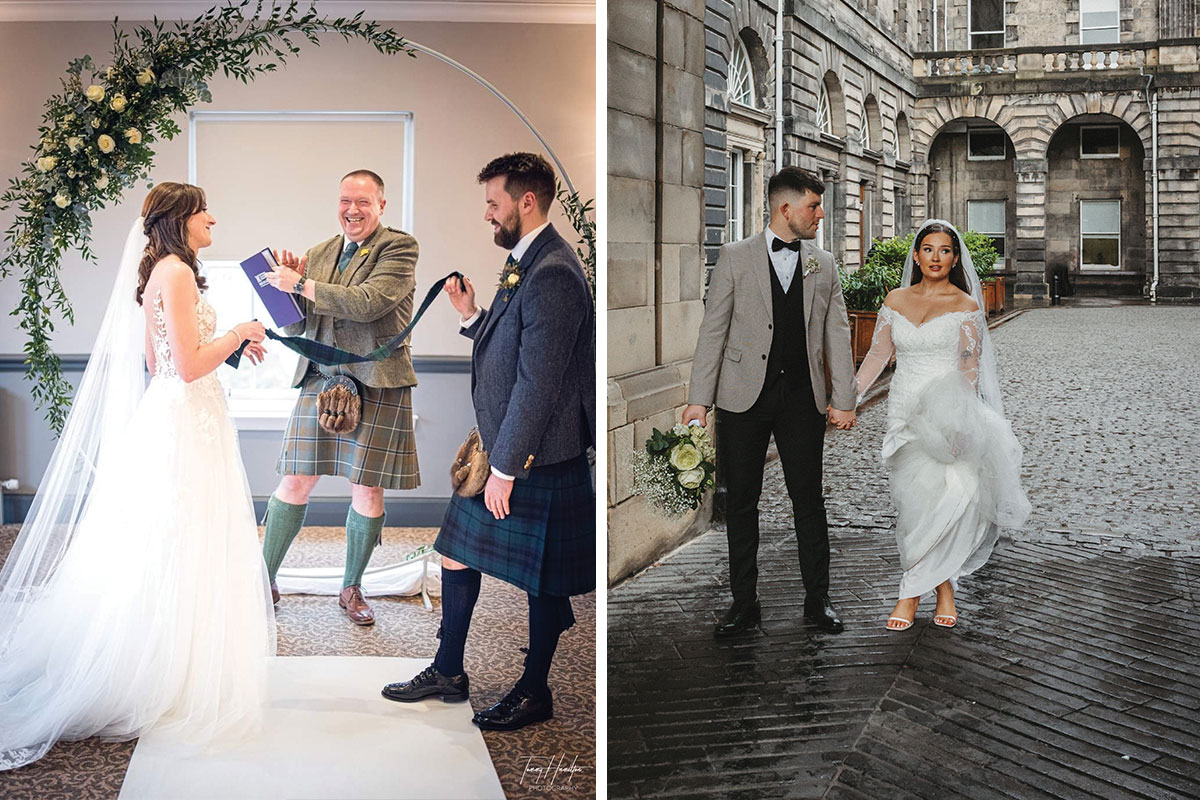
Left: A handfasting during a ceremony by Craig Flowers of Independent Humanist Ceremonies (Photo: Tommy Hamilton Photography); Right: Newlyweds in the courtyard outside Edinburgh City Chambers (Photo: Olive Alexander Photography)
Planning your wedding ceremony
Now that the legal side of it is sorted, here’s some advice about your ceremony to help you determine how yours might look.
How long should the ceremony be?
“The timings are entirely dependent on what you think is best for you, although certain venues may have time limits,” Craig tells us. “The average ceremony lasts around 30 to 40 minutes, which we find works very well. But most celebrants only do one wedding a day, so don’t worry if you’re running late.”
Does our ceremony need to be held at a particular time of day?
“If you marry in the registrar’s office, it will be held between 9.30am and 5pm, generally speaking,” says Tania. “If your ceremony is elsewhere, many registrars and celebrants are happy to officiate at other times – I know registrars who wouldn’t mind going out at midnight or even on Christmas day if that’s what the couple wanted!”
How can we honour lost loved ones during the ceremony?
“It can be incredibly important to a couple to honour those who are no longer with us,” says celebrant Natalie Stevenson. “Some might find it too hard to mention the person who has died, particularly if the circumstances are raw. However, a little nod to those no longer with us can be done in a way that needn’t bring the mood down.
“Some common ways to do this are by lighting a candle, making use of an item belonging to the loved one to tie the handfasting knot, framing a picture, having a memory table or saving a seat. Or there could just be a generalised mention in the ceremony script.”
See more ways to pay tribute to lost loved ones on your wedding day.
Other things to include in your wedding ceremony
Make your wedding ceremony your own! As well as all of the legal requirements you can make this part of your wedding day reflective of you as a couple and can include family and friends.
Why not consider including…
Handfasting – This process sees the couple tie together two pieces of fabric and have their hands bound together with it. To make it more meaningful, use a significant tartan or a garment (such as a tie) that belonged to a cherished friend or family member who has passed away.
Drinking from the quaich – This ritual symbolises love, peace and trust between two people. Whisky is the traditional choice, but it can be filled with any liquid you like – even tea!
Readings or songs – Does your granny have a way with words? Ask her to pen a few lines for a reading. Always dreamt of skipping down the aisle to Cher? Do it!
Check out these amazing ceremony reading ideas.
Ring warming – Get your loved ones involved by asking them to take turns holding your wedding bands and silently saying words of luck and love.
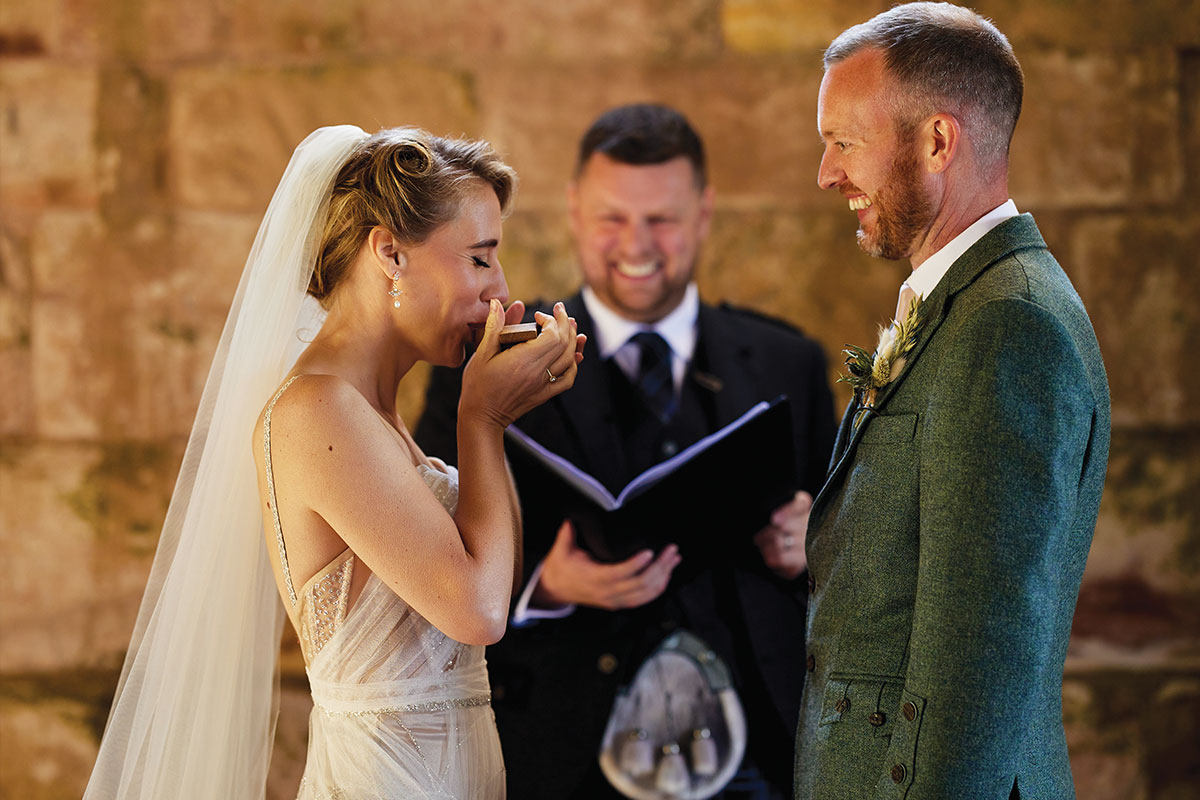
You can fill the quaich with whatever you like to include it in your ceremony (Photo: Natalie Martin Photography)

